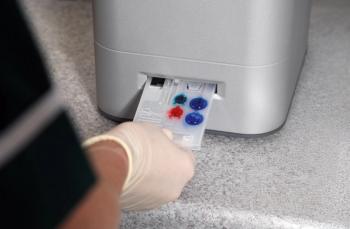
Squeezing in more
Two detail-oriented doctors, technological advances, and a tight floor plan combine at Harden Ranch Veterinary Hospital. The result: 10 pounds of practice in an 8-pound space.
Not Many People Truly Love the process of building a hospital. But Dr. Jeff Hogans, who co-owns Harden Ranch Veterinary Hospital, in Salinas, Calif., with his wife, Dr. Loly Hogans, says he likes the challenge inherent in the building project as much as the finished facility. He just completed his second veterinary hospital and says there's no doubt he'll build again.
"I'm a detail-oriented, go-getter," says Dr. Jeff Hogans. "Building is extremely stressful, and there's a lot of headache involved—but I love it."
Dr. Hogans stayed involved at every step of the design process. He flew from Salinas to Albuquerque, N.M., twice to meet with his architect, and visited the site every single day during construction.
"Jeff knew the construction materials the builders were supposed to use, and he practically memorized the blueprints," says Dr. Loly Hogans. "Almost weekly he'd catch something that needed correction, and I'm thankful for his diligence. Catching problems and making changes early saved us a lot of money."
Today, the Hogans own their second award-winning 4,180-square-foot veterinary practice. The 2005 Veterinary Economics Hospital Design Competition judges particularly praised the facility for its excellent floor plan and traffic flow and for an exciting interior.
Setting the stage
In 1993, Drs. Jeff and Loly Hogans built their first veterinary facility—and won their first Veterinary Economics Hospital Design Competition Merit Award. They stayed in this 2,300-square-foot rental facility for 12 years, far outgrowing the space. As they approached lease renewal time, they decided to build again, this time in a freestanding facility. And, as luck would have it, they found an empty lot across the street that was perfect.
"The demographics are great, and we have a very loyal client following, so we were happy to find a lot so close to our former building," says Dr. Jeff Hogans. "We did face some challenges, however. The lot wasn't zoned for our particular use, and it only had right-in, right-out access, which wasn't ideal."
The Hogans hired a land-use attorney to help them win a zoning code amendment. They completed planned-unit development to get variances so they could squeeze the practice they wanted on the existing site. And they had to fight to get larger signage on the practice, something the commercial offices in the area aren't generally allowed. In the end, they got everything they wanted.
The next challenge? Squeezing a packed-with-features hospital onto a 10,000-square-foot site. "We built the largest building we could fit here and still offer the requisite 10 parking spots," says Dr. Jeff Hogans.
A tight squeeze
"Our architect says we put 10 pounds of hospital in a 8-pound bag," says Dr. Jeff Hogans. In an effort to make everything fit, Drs. Hogans and their architect, Wayne Usiak, AIA, of BDA Architecture in Albuquerque, combined the exam-room hallway with the discharge and checkout area.
Harden Ranch Veterinary Hospital
"Treatment acts as our hub. That approach isn't unique, but it's a design feature that works well for us," says Dr. Jeff Hogans. "We don't have to go far to get anywhere in the hospital. Of course, 4,000 square feet seems spacious, after the small place we practiced in before."
Staff and doctors' offices, as well as the staff lounge/conference room and an outdoor patio, are upstairs. In the old facility, the doctors and staff members ate lunch wherever they could find a free spot; now they have space to spread out.
The doctors included a doctor station that overlooks ICU, a feature from their previous practice. "We like being able to keep an eye on patients while we work on the computer," says Dr. Jeff Hogans. Another repeat feature: paperless records. "We adopted a paperless-practice approach in 1993, and we clearly wanted to continue that strategy here."
Changes, though, were in order for many parts of the practice. In the former building, a big, open reception area turned noisy whenever barking dogs, talking people, and crying children piled in. Now, the check-in, checkout, and waiting areas are separated to reduce noise. And a separate exam hallway away from the lobby also helps keep noise isolated.
Another improvement: Dr. Jeff Hogans insisted on tile and epoxy flooring, and so far he's happy with the result. The linoleum sheet vinyl they installed in the last practice didn't hold up, which spurred the change. "The first time around, we were two young doctors with no money trying to scratch out a practice," he says. "This time, we had a bigger budget and knew a little more."
Getting technical
As a self-described "techno-nerd," Dr. Jeff Hogans naturally wanted to incorporate his passion for electronics into his practice. So the new practice features flat-screen, wall-mounted TVs in each exam room. The Hogans use an infrared system to control a DVD player that's installed in the media room, so they don't need a DVD player in each exam room. Wireless tablets that operate on a wireless network allow computer access to virtually anything anywhere.
Other new technologies include a flat-screen TV in the lobby with a satellite feed and the fastest network possible for the practice's computers. And the Hogans opted for digital radiology with a viewing alcove, instead of a darkroom.
And those white-erase treatment boards that so many hospitals have? Dr. Jeff Hogans is planning to install an electronic white board. Using a touch-screen plasma TV, staff members will be able to drag and drop type to indicate necessary treatments, cross off items, note completed care, and so on. And they can save the information electronically.
"While it's true that I enjoy state-of-the-art tools, staying up to date technologically also elevates clients' perception of your care," Dr. Jeff Hogans says. "For example, the DVDs and digital radiology both improve client education. It's far nicer to sit in a comfortable room and talk privately about radiographs while you look at them on a computer screen. And the TV keeps clients entertained, so they worry less about wait times. Of course, we still need to provide great service. But these tools help us do that job better."
Sarah A. Moser is a freelance writer and editor in Olathe, Kan. Please send questions or comments to
Newsletter
From exam room tips to practice management insights, get trusted veterinary news delivered straight to your inbox—subscribe to dvm360.




